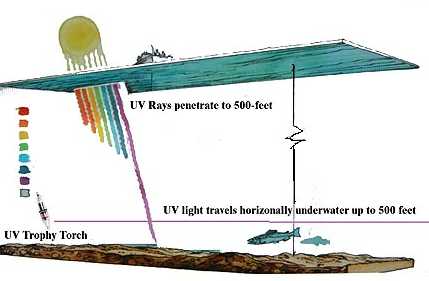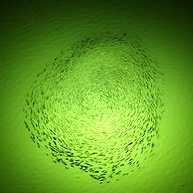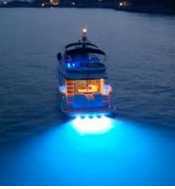Is color important? This is a serious problem, and fishing enthusiasts and fishermen have long been searching for their secrets. Some anglers and fishermen think that the choice of color is crucial, while others say it doesn't matter. Scientifically, there is evidence that both views may be correct. There is ample evidence that choosing the right color can improve the chances of attracting fish when the environmental conditions are right, but science can also show that in other cases, the value of color is limited and not as important as imagined.
The fish was born more than 450 million years and is a very good creature. For thousands of years, they have made many superb adaptive adjustments in the marine environment. The world that lives in the water is not easy, there are high environmental opportunities and serious challenges. For example, the sound is five times faster in the water than in the air, and the water is much better. The ocean is actually a very noisy place. By having good auditory perception, using their inner and lateral lines to detect prey or avoid enemies, fish can take advantage of this. The water also contains unique compounds that fish use to identify other members of their species, find food during the breeding season, detect predators and perform other functions. Fish has developed a remarkable sense of smell and is considered to be a million times better than humans.
However, water is a serious challenge for fish and fishermen for vision and color. Many of the characteristics of light change rapidly with water flow and depth.
What does the attenuation of light bring?
The light that humans see is only a small fraction of the total electromagnetic radiation received from the sun, that is, we see the so-called visible spectrum. The actual color in the visible spectrum is determined by the wavelength of the light: the longer wavelengths are red and orange; the shorter wavelengths are green, blue and purple. However, many fish can see the colors we don't have, including UV rays. Ultraviolet light travels farther in the water than most of us can imagine.

When light enters the water, its intensity drops rapidly and the color changes. These changes are called attenuation. Attenuation is the result of two processes: scattering and absorption. Light scattering is caused by particles or other small objects suspended in water - the more particles, the more scattering. The scattering of light in water is somewhat similar to the effects of smoke or fog in the atmosphere. Due to river input, coastal water bodies usually have more suspended matter, agitating the material from the bottom and increasing plankton. Due to this larger amount of suspended matter, light typically penetrates to a lesser depth. In relatively clear offshore waters, light penetrates deeper into the depths.
Light absorption is caused by several substances, such as light being converted to heat or used in chemical reactions such as photosynthesis. The most important aspect of fishing is the effect of water itself on the absorption of light. For different wavelengths of light, the amount of absorption is different; in other words, the various colors are absorbed differently. Longer wavelengths, such as red and orange, are quickly absorbed and penetrate to a much shallower depth of the shorter blue and purple wavelengths.
Absorption also limits the distance that light enters the water. About three meters (about 10 feet), about 60% of total light (sunlight or moonlight), almost all red light will be absorbed. At 10 meters (about 33 feet), about 85% of the total light and all the red, orange and yellow light have been absorbed. This will seriously affect the effect of the angler's bait. At a depth of three meters, red turns into ice and appears gray. As the depth increases, it eventually turns black. As the depth increases, as all other colors are absorbed, the now dimmed light turns blue and eventually turns black.
The absorption or filtering of color also works in the horizontal direction. So again, a red flight that is only a few feet away from the fish seems to be gray. Again, other colors change with distance. For the color to be seen, it must be hit by the same color of light and then reflected in the direction of the fish. If the water has attenuated or filtered out a color, the color will be gray or black. Due to the large depth of UV light penetration, the fluorescence generated under ultraviolet radiation is an important part of the underwater rich environment.
What is the best color for light-sucking fish?
Scientists really don't know what fish to see, in other words, what images reach their brains. Most studies of fish vision are performed by physical or chemical examination of different parts of the eye, or by determining how the fish in the laboratory react to various images or stimuli. It may not be scientific to conclude that the fish's visual ability is highly consistent and deterministic through the fact that different species may have different visual capabilities and that laboratory results may not represent what is happening in the real world of oceans, lakes or rivers.
Physical studies of the eye and retina have shown that most people can obtain sharply focused images, detect motion, and have good contrast detection capabilities. And there are plenty of experiments that show that the minimum level of light is needed before the fish can recognize the color. As the research progresses, different fish have a particular color.
Most fish have sufficient vision, but sound and smell play a more important role in the fish's access to food or natural enemies. Fish usually use their hearing or smell to initially perceive their prey or natural enemies and then use their vision in the final attack or escape. Some fish can see objects at medium distances. Fish such as tuna are particularly good in sight; but under normal circumstances. The fish is myopic, although the shark's vision is quite good.
Just as fishermen seek to optimize the chances of catching fish, fish are also looking for the best areas for food capture. Most game fish look for waters rich in food such as fish, insects or shrimps. Moreover, these smaller fish, insects and shrimps gather where food is most concentrated.
Scientific research shows that all members of this food chain are sensitive to blue and green colors. This may be due to the absorption of longer wavelengths by water (Mobley 1994; Hou, 2013). The color of the water depends largely on the internal composition, combined with the absorption spectrum of the light in the water. The colored organic matter in the water will quickly absorb blue light, then turn green, then turn yellow (exponentially decays to wavelength), making the water brown. Keep in mind that the light transmission window in the water is very narrow and the red light is quickly absorbed.

Some members of fish and their food chains have color receptors in their eyes that are optimized for their "space" light. It can be seen that a single spatial color of the eye can detect changes in light intensity. This is equivalent to a world of black, white and gray shades. At this level of the simplest visual information processing, animals can recognize that something is different in its space, ie there is food or predator there. Most animals living in the lighting world have additional visual resources: color perception. By definition, this requires that they have a color acceptor containing at least two different visual pigments. In order to perform this function effectively in water illuminated with light, the aquatic animal will have a visual pigment that is sensitive to the "spatial" color of the background and one or more visual colors that deviate from the blue-green region, such as in the red or ultraviolet region of the spectrum. . This provides a clear survival advantage for these animals because they not only detect changes in light intensity, but also the contrast of colors.
For example, many fish have two color receptors, one in the blue region of the spectrum (425-490 nm) and the other in the near ultraviolet (320-380 nm). Insects and shrimp, members of the fish food chain, have blue, green (530 nm) and near-UV receptors. In fact, some aquatic animals have as many as ten different types of visual pigments in their eyes. In contrast, humans have the three most sensitive sensitivities in blue (442 nm), green (543 nm), and yellow (570 nm).

For a long time, we have learned that light can attract fish, shrimp and insects at night. But what is the best color for light to attract fish? Based on the biology of the above visual receptors, the light should be blue or green. However, although blue or green light is desirable, it is not required. Even though the eyes of members of the fish or its food chain have the most sensitive color receptors for blue or green, these same receptors are very sensitive to other color sensitivities. Therefore, if a fishing light source is strong enough, other colors will also attract fish. For example, a yellow sodium lamp will attract the fish - if it is strong enough. But undoubtedly, the energy consumption of sodium lamps is quite high.
Why do some fish feel polarized?
Recent studies have shown that many fish are polarized. Humans do not have the ability to separate polarization from normal light. Conventional light vibrates in all directions perpendicular to its direction of travel; however, polarized light only vibrates in one plane. When light is reflected by many non-metallic surfaces, including ocean surfaces, it is polarized to some extent. This explains the working principle of polarized sunglasses: they block the horizontally reflected polarization component from the ocean surface, which causes most of the glare, but allows vertical reflection of the components to pass.
It is not entirely clear why some fish can perceive polarized light, and the ability to detect polarized light may be related to the fact that when light is reflected by the surface, like the scales on the bait fish, it is polarized. Fish that can detect polarized light have an advantage in finding food. Polarized vision also enhances the contrast between the almost transparent prey and the background, making the prey easier to see. Another conjecture is that having polarized vision allows the fish to see objects that are far away—three times the usual visual distance—and fish without this ability require brighter light.
Why are light sticks particularly popular with fishermen?
The color of fluorescent lamps, especially light sticks, is very popular with fishermen. Drop the glow stick into the water, even if you just have a look at the area. Under the right conditions, the fluorescence color is very visible under water. Fluorescence is produced when exposed to light radiation having a shorter wavelength. For example, when exposed to ultraviolet, blue or green light, the fluorescent yellow color is shown as bright yellow.
The fluorescence of fluorescent colors is mainly due to ultraviolet (UV) light, which is our invisible color. Humans don't see ultraviolet light, but we can see how it brings out the fluorescence of certain colors. Ultraviolet light is particularly advantageous in cloudy or gray days, and when ultraviolet light is irradiated with fluorescent materials, its color becomes particularly noticeable and vibrant. On sunny days, the fluorescence is much smaller, and of course there is no fluorescence if there is no light.
Studies have shown that fluorescent colors are visible and distinct over longer distances than conventional colors, and baits with fluorescent materials are generally more attractive to fish (increasing contrast and transmission distance). More precisely, a fluorescent color having a wavelength slightly longer than the color of water has better long-distance visibility.
As you can see, light and color can become quite complicated. Fish are not very smart, they attack prey or bait as one or more instinctive behaviors that stimulate motivation. These stimuli include movement, shape, sound, contrast, smell, color and other things we don't know. Of course we need to consider other variables, such as the time of day, tides and other fish or aquatic environments.
As can be seen above, the perfect LED underwater fishing light has the following characteristics: 1) high intensity, 2) emitting its light in a color similar to fish space (blue or green), 3) powered by a portable power source, 4) deep water Operability and stability 5) Use of polarized optical materials and fluorescent materials 6) Intelligent control and integration of odor, sound, spectrum and moving light patterns.
Kollmorgen Servo Motor Replacement
Kollmorgen Servo Motor Replacement Product Features:
1. During acceleration and deceleration and returning to the origin, the impact of the Servo Motor is small, the response is fast, and the vibration is low;
2. The servo motor runs smoothly without noise, the speed control accuracy is ±1rpm, and the control accuracy is ±1 pulse/r;
3. The highly integrated design can effectively save 50% of the installation space, which is conducive to the realization of mechanical miniaturization and high efficiency;
4. Reduce installation complexity, move flexibly, deploy easily, and provide a friendly and simple user experience;
5. Reliable quality, stable operation, simple debugging, convenient maintenance, etc.;
6. The rated speed of the servo motor is 3000rpm, and the instantaneous maximum speed reaches 6000rpm, which can meet the requirements of high-speed operation.
Kollmorgen Servo Motor Replacement,High Torque Digital Servo,High Torque Metal Gear Servo,Brushless Servo
Kassel Machinery (zhejiang) Co., Ltd. , https://www.kasselservo.com
